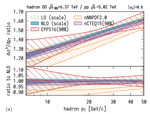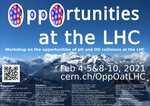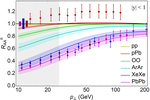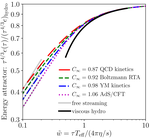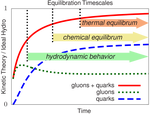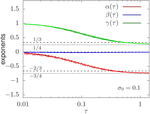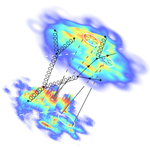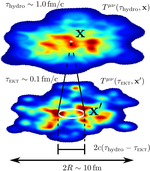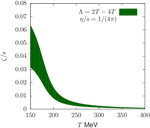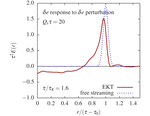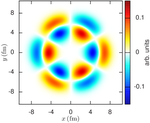Publications
Prescaling relaxation to nonthermal attractors
We study how isotropic and homogeneous far-from-equilibrium quantum systems relax to nonthermal attractors, which are of interest for …
Predictions for the sPHENIX physics program
sPHENIX is a next-generation detector experiment at the Relativistic Heavy Ion Collider, designed for a broad set of jet and …
Bayesian uncertainty quantification of perturbative QCD input to the neutron-star equation of state
The equation of state of neutron-star cores can be constrained by requiring a consistent connection to the perturbative Quantum …
Medium-enhanced $c\bar{c}$ radiation
We show that the same QCD formalism that accounts for the suppression of high-$p_T$ hadron and jet spectra in heavy-ion collisions …
The medium-modified $g\to c\bar{c}$ splitting function in the BDMPS-Z formalism
The formalism of Baier-Dokshitzer-Mueller-Peigné-Schiff and Zakharov determines modifications of parton splittings in the QCD plasma …
Stability analysis of nonthermal fixed points in longitudinally expanding kinetic theory
We use the Hamiltonian formulation of kinetic theory to perform a stability analysis of non-thermal fixed points in a non-Abelian …
Ratios of jet and hadron spectra at LHC energies: Measuring high-pT suppression without a pp reference
In this work we analyze the reliability of several techniques for computing jet and hadron spectra at different collision energies. …
Effect of thermal shear on longitudinal spin polarization in a thermal model
By including the recently introduced thermal shear term that contributes to the spin polarization vector at local equilibrium, we …
Opportunities of OO and $p$O collisions at the LHC
This is the summary document of the virtual workshop “Opportunities of OO and pO collisions at the LHC”, which took place …
The multiple-charm hierarchy in the statistical hadronization model
In relativistic nuclear collisions the production of hadrons with light (u,d,s) quarks is quantitatively described in the framework of …
Collective flow in single-hit QCD kinetic theory
Motivated by recent interest in collectivity in small systems, we calculate the harmonic flow response to initial geometry deformations …
An analysis of Bayesian estimates for missing higher orders in perturbative calculations
With current high precision collider data, the reliable estimation of theoretical uncertainties due to missing higher orders (MHOs) in …
Predicting parton energy loss in small collision systems
Medium induced parton energy loss is not conclusively established neither in very peripheral heavy-ion collisions nor in proton-ion …
Discovering partonic rescattering in light nucleus collisions
We demonstrate that oxygen-oxygen (OO) collisions at the LHC provide unprecedented sensitivity to parton energy loss in a system whose …
Thermalization in QCD: theoretical approaches, phenomenological applications, and interdisciplinary connections
Heavy-ion collisions at BNL’s Relativistic Heavy-Ion Collider (RHIC) and CERN’s Large Hadron Collider (LHC) provide strong …
QCD Challenges from pp to A-A Collisions
This paper is a write-up of the ideas that were presented, developed and discussed at the third International Workshop on QCD …
Dynamics of critical fluctuations: Theory – phenomenology – heavy-ion collisions
This report summarizes the presentations and discussions during the Rapid Reaction Task Force Dynamics of critical fluctuations: Theory …
Probing the evolution of heavy-ion collisions using direct photon interferometry
We investigate the measurement of Hanbury Brown-Twiss (HBT) photon correlations as an experimental tool to discriminate different …
Global fluid fits to identified particle transverse momentum spectra from heavy-ion collisions at the Large Hadron Collider
Transverse momentum spectra of identified particles produced in heavy-ion collisions at the Large Hadron Collider are described with …
Hydrodynamic attractors, initial state energy and particle production in relativistic nuclear collisions
We exploit the concept of hydrodynamic attractors to establish a general relation between the initial state energy and the produced …
Entropy production in pp and Pb-Pb collisions at the LHC
We use experimentally measured identified particle spectra and Hanbury Brown-Twiss radii to determine the entropy per unit rapidity …
Temperature and fluid velocity on the freeze-out surface from $π$, $K$, $p$ spectra in pp, p-Pb and Pb-Pb collisions
We present a new approach to take into account resonance decays in the blast-wave model fits of identified hadron spectra. Thanks to …
Longitudinal spin polarization in a thermal model
We use a thermal model with single freeze-out to determine longitudinal polarization of $\Lambda$ hyperons emitted from a hot and …
Chemical equilibration in weakly coupled QCD
We study thermalization, hydrodynamization, and chemical equilibration in out-of-equilibrium quark-gluon plasma starting from various …
Chemical equilibration in hadronic collisions
We study chemical equilibration in out-of-equilibrium Quark-Gluon Plasma using the first principle method of QCD effective kinetic …
Prescaling and far-from-equilibrium hydrodynamics in the quark-gluon plasma
Prescaling is a far-from-equilibrium phenomenon which describes the rapid establishment of a universal scaling form of distributions …
Fast resonance decays in nuclear collisions
In the context of ultra-relativistic nuclear collisions, we present a fast method for calculating the final particle spectra after the …
Matching the Nonequilibrium Initial Stage of Heavy Ion Collisions to Hydrodynamics with QCD Kinetic Theory
High-energy nuclear collisions produce a nonequilibrium plasma of quarks and gluons which thermalizes and exhibits hydrodynamic flow. …
Effective kinetic description of event-by-event pre-equilibrium dynamics in high-energy heavy-ion collisions
We develop a macroscopic description of the space-time evolution of the energy-momentum tensor during the pre-equilibrium stage of a …
Bulk viscosity from hydrodynamic fluctuations with relativistic hydrokinetic theory
Hydrokinetic theory of thermal fluctuations is applied to a nonconformal relativistic fluid. Solving the hydrokinetic equations for an …
Fluctuations in ultra-relativistic heavy ion collisions
Fluctuations are one of the main probes of the physics of the new state of hot and dense nuclear matter called the Quark Gluon Plasma …
A kinetic regime of hydrodynamic fluctuations and long time tails for a Bjorken expansion
We develop a set of kinetic equations for hydrodynamic fluctuations which are equivalent to nonlinear hydrodynamics with noise. The …
Initial conditions for hydrodynamics from weakly coupled pre-equilibrium evolution
We use effective kinetic theory, accurate at weak coupling, to simulate the preequilibrium evolution of transverse energy and flow …
Fluctuations of harmonic and radial flow in heavy ion collisions with principal components
We analyze the spectrum of harmonic flow, vn(pT) for n=0–5, in event-by-event hydrodynamic simulations of Pb+Pb collisions at the CERN …
Subleading harmonic flows in hydrodynamic simulations of heavy ion collisions
We perform a principal component analysis (PCA) of v3(pT) in event-by-event hydrodynamic simulations of Pb+Pb collisions at the Large …


